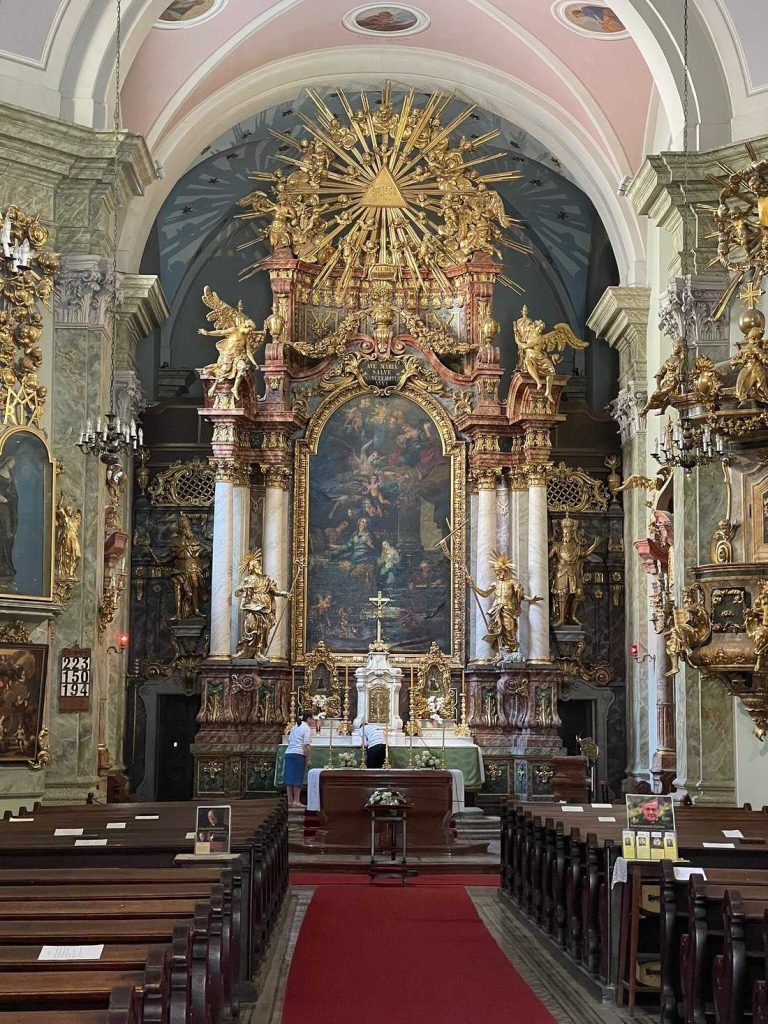St. Anna Church: A Gothic Masterpiece in Budapest’s Heart
St. Anna Church, nestled in the Buda side of Budapest near Batthyány Square, is not just a religious tower; it’s a symbol of the city’s resilience and a masterpiece of Gothic architecture. As an expert in Budapest’s architectural heritage, I invite you to delve into this remarkable church’s rich history and artistic splendor.
A Historical Beacon of Faith and Artistry
Constructed between 1740 and 1761 on the foundations of an older chapel under the guidance of architects Hamon Kristóf and Nepauer Máté, St. Anna Church has weathered floods, sieges, and the destruction of World War II. It silently witnesses Budapest’s tumultuous past and embodies its enduring spirit.
Architectural Marvels and Symbolic Gateways
Upon approaching St. Anna Church, the basket-arched main gate, adorned with statues representing Faith, Hope, and Love, captivates visitors. This gate, reconstructed post-World War II by Jenő Grandtner, sets the stage for the wonders within. The façade, with its chronostichon window and statue of St. Anna, hints at the artistic richness inside.
Inside the Gothic Sanctuary
The interior of St. Anna Church contrasts its exterior with a central dome that imparts a sense of grandeur and openness. The organ loft, framed by towers, and the sanctuary form the heart of the church, surrounded by side chapels and overhead oratories that invite exploration and contemplation.
A Treasure Trove of Artistic Masterpieces
The main altar, created by Károly Bebó between 1771 and 1773, is an elaborate spectacle not to be missed. The sanctuary’s dome, adorned with Gergely Vogl’s frescoes, combines religious symbolism with artistic expression. The church’s interior is further enriched by various paintings, sculptures, and artworks, each with its own story and significance.
A Must-Visit for Art and History Enthusiasts
St. Anna Church is an essential destination for anyone interested in art, architecture, or history. Its blend of historical resilience, Gothic beauty, and artistic treasures makes it a unique and enriching experience for visitors.
Did you know about the St. Anna Church?
The Church of St. Anne (Szent Anna-templom in Hungarian), located in Budapest, Hungary, is an architectural and historical gem. Here are some key facts about this church:
- Architectural Style: The Church of St. Anne is renowned for its exquisite Baroque architecture. It is considered one of the finest examples of Italian Baroque architecture in Budapest and is often compared to the Jesuit Church in Vienna due to its architectural similarities.
- Historical Background: Construction on the church began in the 1740s and was completed by the late 18th century. Kristóf Hamon initially led the project, followed later by Mátyás Nepauer and Miklós Ybl, notable figures in Hungarian architecture.
- Location: The church is situated in the Buda side of Budapest, in the Batthyány Square, near the Danube riverbank. This location places it in a picturesque setting, easily accessible and visible from various points in the city.
- Interior and Artwork: The interior of the Church of St. Anne is as remarkable as its exterior. It features rich decorations, including frescoes, altars, and sculptures. The high altar, dedicated to Saint Anne (the mother of the Virgin Mary), is particularly notable for its artistic value.
- Preservation and Renovation: Over the centuries, the church has undergone several renovations to preserve its structure and artistic integrity. These renovations have ensured that both the interior and exterior remain in excellent condition, reflecting the original Baroque elegance.
- Cultural Significance: The Church of St. Anne is a place of worship and a cultural and historical monument. It holds a special place in Budapest’s heritage, representing Baroque artistry and religious history in Hungary.
- Tourist Attraction: The church is a popular tourist attraction, admired for its architectural beauty and historical importance. Visitors are often captivated by its magnificent façade and the artful details of its interior.
- Active Place of Worship: Despite its historical and architectural significance, the Church of St. Anne remains an active place of worship, hosting religious services and events and playing an important role in the local Catholic community.
The Church of St. Anne in Budapest is a testament to Baroque art and architecture. It is a beautiful and enduring symbol of the city’s rich cultural and religious history.
In conclusion, St. Anna Church is a jewel in Budapest’s architectural crown, where history, art, and spirituality converge. Whether seeking artistic inspiration, historical insights, or a moment of peace, this church offers a sanctuary that transcends time, inviting you to connect with Budapest’s rich cultural and religious heritage. As you walk through its arches and gaze upon its artworks, you’re not just visiting a church but experiencing a piece of Budapest’s soul.

